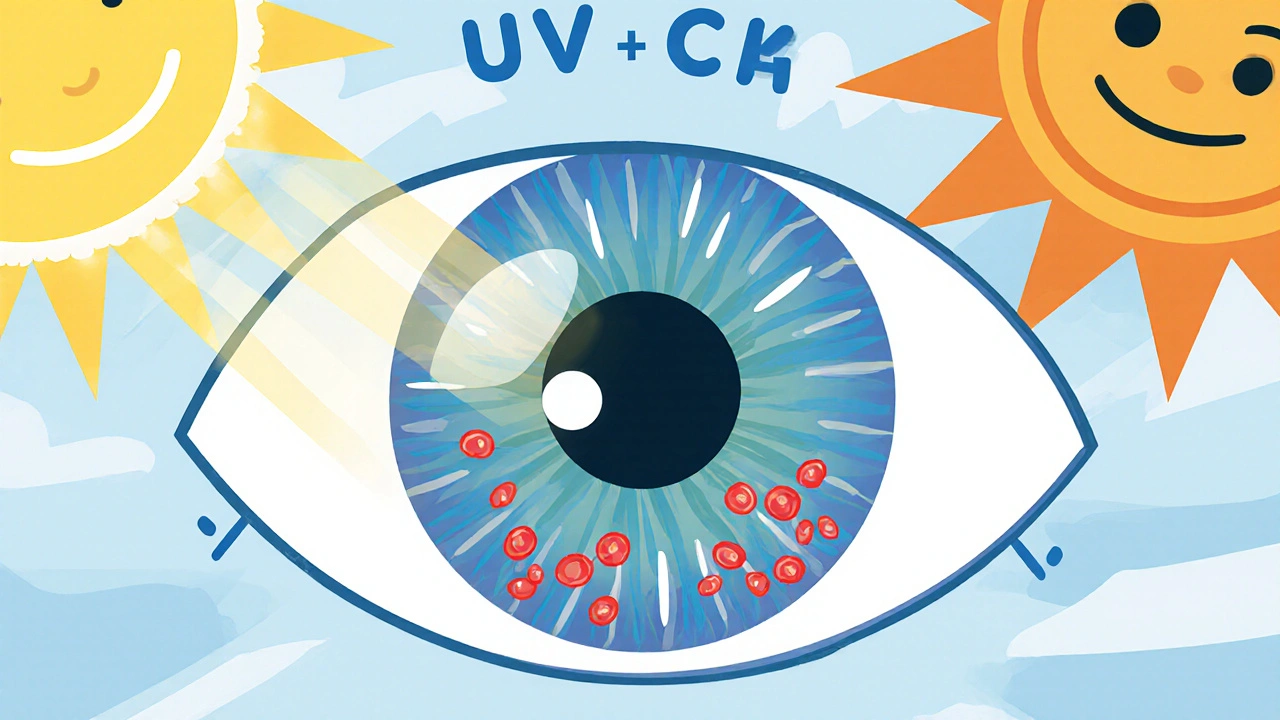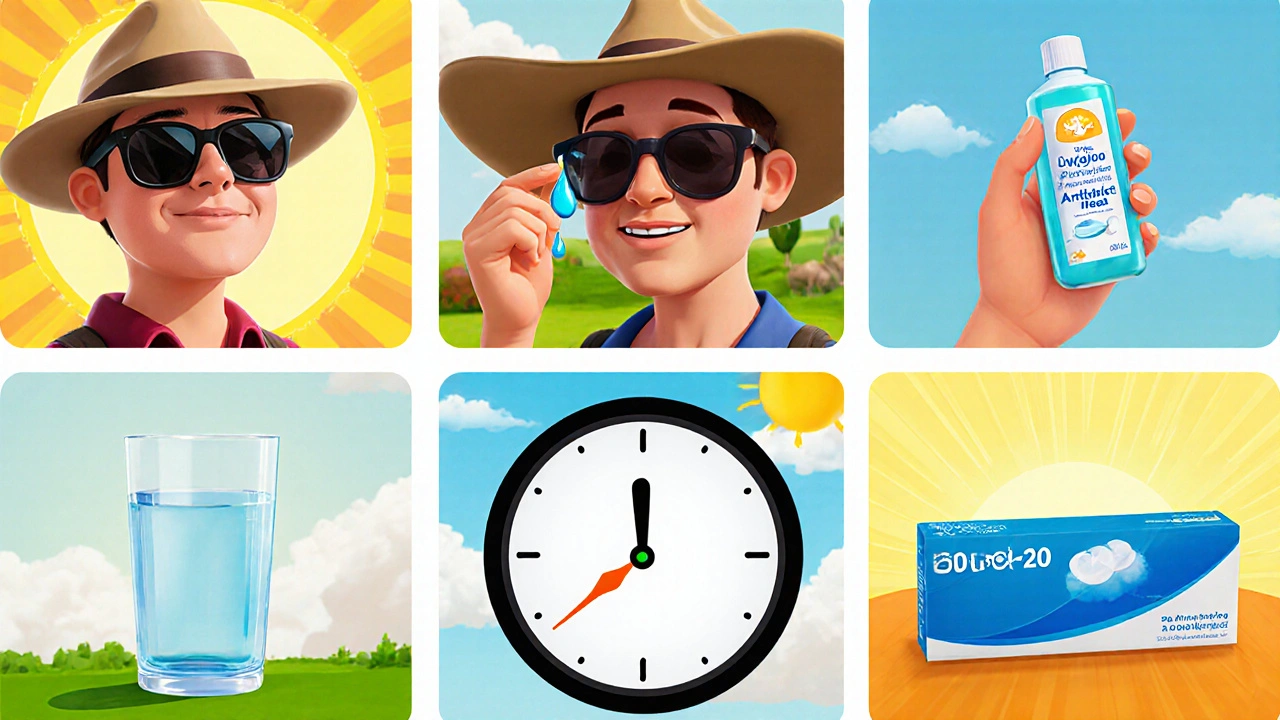UV Exposure & Eye Protection Calculator
This tool calculates your UV exposure risk based on your current location and helps you determine the best eye protection strategy to prevent sun-induced redness.
UV Exposure Risk
Recommended Protection
Ever stepped out on a bright day and noticed your eyes feeling gritty, irritated, or turning pink? That’s the classic sign of eye redness caused by the sun. The UV rays that make your skin tan can also inflame the delicate tissues around your eyes, leaving you uncomfortable and looking a bit washed‑out. In this guide we’ll break down why the sun sparks eye redness, what other factors can make it worse, and give you seven practical steps to keep your peepers cool, clear, and comfortable.
What Actually Happens When UV Light Hits Your Eyes
When sunlight reaches your eyes, a portion of it is ultraviolet (UV) radiation. UV Radiation is a type of electromagnetic energy from the sun that can damage skin and eye tissues if you’re not protected. The eye’s outer layer, the cornea, absorbs most UV‑B rays, while UV‑A can penetrate deeper into the conjunctiva, the thin membrane covering the white of the eye. This absorption triggers an inflammatory response: blood vessels dilate, fluid leaks into surrounding tissues, and you end up with the characteristic redness.
Why Some People Get Redder Than Others
Not everyone reacts the same way to sunlight. Several personal and environmental factors amplify the risk:
- Dry Eye Syndrome is a chronic condition where the eye doesn’t produce enough tears or the tears evaporate too quickly, leaving the ocular surface vulnerable to UV‑induced irritation.
- Age: Older adults have thinner lenses that block less UV, and tear production declines with age.
- Geography: Higher altitudes and equatorial locations boost UV intensity.
- Medications: Antihistamines and certain antidepressants can reduce tear production.
- Contact lens wear: Some lenses trap heat and reduce oxygen flow, worsening inflammation.
Common Symptoms to Spot Early
Knowing the early signs helps you act before the redness turns into a full‑blown eye problem. Look out for:
- Pink or blood‑shot eyes
- A burning or gritty sensation
- Watery or teary eyes
- Sensitivity to light (photophobia)
- Swollen eyelids
If these symptoms linger for more than a day, it’s time to consider professional care.

Seven Proven Tips to Shield Your Eyes from Sun‑Induced Redness
- Sunglasses are protective eyewear that blocks at least 99% of UV‑A and UV‑B rays. Look for lenses labeled "UV 400" and wrap‑around frames that reduce peripheral glare.
- Protective Hats are wide‑brimmed hats that shade the eyes and reduce UV exposure by up to 50%. A brim of 3 inches or more works best.
- Use Artificial Tears lubricating eye drops that restore moisture to the ocular surface before and after outdoor activities. Choose preservative‑free formulas if you wear contacts.
- Take regular “20‑20‑20” breaks when working outdoors or under bright screens: every 20 minutes, look 20 feet away for 20 seconds. This reduces strain and helps the tear film reset.
- Stay hydrated. Drinking water supports tear production and helps keep the eye’s surface slick.
- Avoid rubbing your eyes. The mechanical action can damage tiny blood vessels and spread irritants.
- If you wear contact lenses, consider switching to daily disposables on sunny days. They lower the risk of debris buildup and improve oxygen flow.
Quick Comparison of Everyday Protection Options
| Method | UV Blocking Efficiency | Convenience | Cost (USD) |
|---|---|---|---|
| Sunglasses (UV 400) | 99‑100% | High - wear daily | 30‑150 |
| Protective Hat | ~50% (shading) | Medium - wear with outdoor gear | 20‑60 |
| Artificial Tears (drops) | N/A (moisture only) | High - portable bottle | 5‑20 |
| Contact Lens Switch (daily disposables) | Depends on lens - some have UV coating | Medium - need supply | 25‑40 (monthly supply) |

When Sun‑Related Redness Needs Professional Attention
If you experience any of the following, schedule an eye exam promptly:
- Severe pain or a sudden loss of vision
- Persistent redness lasting more than 48 hours
- Blurred vision that doesn’t clear with rest
- Visible scratches or foreign bodies in the eye
- Symptoms of Photokeratitis is a sunburn of the cornea that can cause intense pain and temporary vision loss, such as after a day at the beach without protection.
An optometrist can differentiate ordinary redness from infections like Conjunctivitis is inflammation of the conjunctiva often caused by bacteria, viruses, or allergens and prescribe appropriate drops or medication.
Simple Daily Habits to Keep Your Eyes Happy
Beyond the big protective steps, tiny tweaks can make a big difference:
- Use a humidifier in dry indoor environments to keep the tear film stable.
- Limit caffeine and alcohol, which can dehydrate you.
- Choose matte screen protectors on phones and computers to reduce glare.
- Eat omega‑3‑rich foods (salmon, flaxseeds) that support tear quality.
Combining these habits with solid UV protection creates a robust defense against that annoying pink eye after a sunny outing.
Frequently Asked Questions
Can I get eye redness from the sun even on cloudy days?
Yes. Up to 80% of UV rays penetrate clouds, so you can still experience inflammation without direct sunlight. Wearing UV‑blocking sunglasses is a good habit regardless of the weather.
Are polarized lenses better for preventing redness?
Polarization reduces glare but doesn’t guarantee UV protection. Look for lenses that state "UV 400"; many polarized pairs include that rating, making them an excellent all‑around choice.
How often should I replace my sunglasses?
If the frames are still sturdy and the lenses aren’t scratched, they can last years. However, UV‑blocking coatings degrade over time-replace them every 2‑3 years or after a major impact.
Do eye drops help if my redness is caused by the sun?
Lubricating drops can soothe irritation and restore moisture, but they don’t block UV. Use them alongside proper shading for the best results.
Is it safe to wear contact lenses without sunglasses?
Not ideal. Contacts reduce oxygen flow and can trap heat, making UV‑induced inflammation worse. If you must be outdoors, wear UV‑blocking glasses over your lenses or switch to daily disposables.

Stephanie S
October 16, 2025 AT 16:40Wow, what a thorough breakdown-thank you for covering both the science and the practical steps! The way you explained UV‑A versus UV‑B in the cornea and conjunctiva was crystal‑clear, and the inclusion of common risk factors like dry‑eye syndrome and certain medications really helped me contextualize my own experiences. I especially appreciated the tip about “wrap‑around” frames; they’re often overlooked, yet they cut peripheral glare dramatically.
Also, the table comparing costs makes choosing the right gear much easier. Keep up the excellent work; this guide will definitely become my go‑to reference for sunny days!
HARI PRASATH PRASATH
October 23, 2025 AT 04:23Honestly, anyone who thinks a simple pair of sunglasses will solve all UV‑induced inflammation clearly lacks a nuanced understanding of ocular photobology. The article, while adequate, omits the subtle distinction between UV‑blocking coatings and mere tint-an oversight that could mislead the lay reader. Moreover, the suggestion to replace lenses every few years ignores the advances in durable polymer technology that render such frequency unnecessary. Nonetheless, the core advice aligns with established optometric protocols, albeit presented in an overly simplistic fashion.
Andrew Miller
October 29, 2025 AT 15:06My eyes always burn after a quick jog, so I’ll try the artificial tears tonight.
Brent Herr
November 5, 2025 AT 02:50It’s shameful how many people ditch basic eye protection and then complain about redness-if you’re not willing to wear a decent pair of UV400 sunglasses, stop blaming the sun for your own negligence. We have a responsibility to ourselves and to the community to model proper preventative habits, not to flaunt reckless behavior that normalizes avoidable discomfort. Choose wisely, protect your vision, and stop making excuses.
Julius Adebowale
November 11, 2025 AT 14:33UV rays cause vasodilation in the eye surface leading to redness It’s a straightforward inflammatory response; sunglasses with UV400 rating prevent most of it. Use artificial tears if you’re already irritated. Stay hydrated.
KISHORE KANKIPATI
November 18, 2025 AT 02:16Hey folks! 🌞 Let's celebrate the sunshine instead of fearing it-by simply slipping on a pair of groovy, UV‑blocking shades, we can keep those lovely peepers sparkling. Think of your eyes as tiny gardens; a good hat and some drops are the watering can and sun‑shade that keep the blossoms vibrant. No need for drama, just a splash of smart style and a dash of hydration, and we’re all set for the next beach day!
Garreth Collard
November 24, 2025 AT 14:00Picture this: the golden sun blazing overhead, a gentle breeze, and suddenly-bam!-the dreaded pink flare of ocular distress. It’s as if the heavens themselves conspired to test our resolve. Yet, armed with the aristocratic elegance of UV‑400 spectacles and the regal comfort of a wide‑brimmed hat, we rise above the petty assault of photons. Trust me, dear readers, the drama ends the moment you treat your eyes like the precious canvases they are.
Daniel LaMontagne
December 1, 2025 AT 01:43Totally agree with the tips! 😎 Especially the 20‑20‑20 rule-it’s a game‑changer for screen‑time and outdoor work. Keep those drops handy and stay hydrated, friends! 💧👍
Gary Levy
December 7, 2025 AT 13:26The guide nails the basics, but let me add a nuance: while sunglasses block the majority of UV, they don’t address the mechanical irritation from wind, which can also exacerbate redness. A simple wind‑breaker or even a lightweight scarf can act as a barrier, especially for those who spend hours biking or hiking. Also, consider the fit of your frames; too loose and stray light sneaks in, too tight and you risk pressure on the temples.
sourabh kumar
December 14, 2025 AT 01:10sun protection is important but many people think only UV is the problem while glare and wind also cause irritation may be worth noting and maybe more affordable options exist too
Christian Miller
December 20, 2025 AT 12:53While the article adequately outlines conventional protection strategies, it subtly omits the larger narrative of how regulatory bodies have historically down‑played the long‑term ocular hazards of sub‑optimal UV filtration in order to protect lucrative eyewear manufacturers. One must therefore scrutinize the provenance of “UV‑400” certifications and consider independent lab results before placing blind trust in marketed claims.